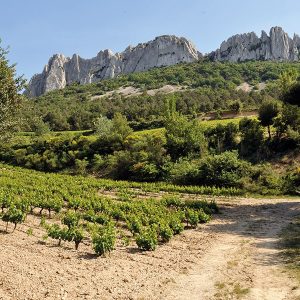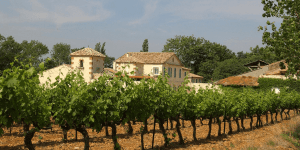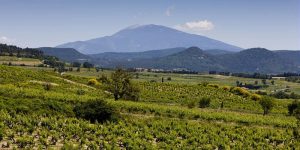North versus south
‘Côtes du Rhône’ is an umbrella denomination for all wines produced on the right and left banks of the Rhône, between the towns of Vienne and Avignon. This appellation is divided into two sub-regions: méridionale (or south, from Avignon to Valence), and septentrionale (north, from Valence to Vienne).
The wines from north Côtes du Rhône are generally made from a single variety such as Syrah for reds and Viognier or Marsanne for whites. We call these ‘single varietal wines’.
As we descend, south Côtes du Rhône is the source of a wide palette of grape varieties that has made it one of the most reputable wine-making regions. In Châteauneuf-du-Pape, for example, 13 grape varieties are authorised to produce red wines. We call these ‘blends’.
Now you have a clearer idea of the region covered by this appellation and the distinction between north and south for Côtes du du Rhône wines, let’s go into more detail.
Focus on Côtes-du-Rhône Villages
The Côtes-du-Rhône Villages PDO is a classification for a large swathe of the south Côtes du Rhône region and spans four départements (the French equivalent of a county): Ardèche, Drôme, Gard and Vaucluse. It comprises 95 production villages. The mention Côtes-du-Rhône Villages on the label is often accompanied by one of 18 individual communes. In Drôme, these are:
Rochegude, Rousset les Vignes, Saint Maurice and Saint Pantaléon les Vignes. In Gard: Chusclan, Laudun, Saint Gervais and Signargues. The majority are in Vaucluse: Gadagne, Massif d’Uchaux, Plan de Dieu (wines you can find in our Domaine de Longue Toque and Gabriel Meffre ranges), Puyméras, Roaix, Sablet, Séguret, Valréas and Visan.
Crus in Côtes du Rhône
After the Côtes-du-Rhône Villages, the highest tier in the hierarchy includes the Crus, the majority of which are produced by Gabriel Meffre:
- Beaumes-de-Venise Red and Muscat de Beaumes-de-Venise (Laurus)
- Cairanne (Gabriel Meffre White)
- Château-Grillet
- Châteauneuf-du-Pape (Laurus Red, Gabriel Meffre Red)
- Condrieu (Laurus White)
- Cornas, Saint-Péray
- Côte-Rôtie (Laurus Red)
- Côtes-du-Rhône Villages is home to many geographic denominations which we will explain in more detail…
- Crozes-Hermitage (Laurus Red, Gabriel Meffre Red)
- Gigondas (Domaine de Longue Toque, Hommage à Gabriel Meffre, Laurus, Gabriel Meffre, 1936, all reds)
- Hermitage (Laurus White and Red)
- Lirac
- Rasteau
- Saint-Joseph (Laurus Red, Gabriel Meffre Red)
- Tavel (Gabriel Meffre rosé)
- Vacqueyras (Domaine de Longue Toque, Laurus, Gabriel Meffre, all reds)
- Vinsobres
Rising up the ranks to the Crus family is an indication of greater refinement of the specificity of a Côtes du Rhône wine and comes with a more esteemed reputation.
Rigorous specifications
To reap the benefit of the Côtes-du-Rhône PDO, wines are required to meet a precise set of specifications that establishes the common foundation of the appellation.
Regarding Côtes-du-Rhône Villages, the specifications were extended with additional requirements. “The higher you ascend in the pyramid of wines, the more restrictive the conditions for growing and producing wines become and the more rigorous the specifications,” explains Valérie Vincent, Marketing & Communications Manager.
Generally speaking, the main thrust of an appellation’s specifications is the constant search for quality in line with the rules dictated by the INAO, France’s National Institute for Appellations of Origin that grants appellation status. Valérie goes on to specify that, “Each appellation has its own strict rules: authorised grape varieties and percentages, yields by hectare, vinification method, and so on.”
It takes on average three to five years to satisfy any request for a new appellation or effect a change in the hierarchy (rising from a Côtes du Rhône Villages to a Cru, for instance). By way of example, the Gigondas PDO currently exists for red and rosé. The INAO’s regional committee is soon going to receive a request to produce Gigondas white.
Since 1936, Gabriel Meffre has been established in Gigondas, in the heart of the Côtes du Rhône. We offer our customers a very comprehensive offering of all the appellations: Côtes du Rhône, Côtes du Rhône Villages and Crus, crafted using methods that protect our terroirs to produce wines that everyone can enjoy. We are always happy to meet you in person so you can see for yourself! Don’t hesitate to visit our cellar or check out our on-line store.
Rubrics
Découvrez plus d'articles...

The vineyard and wine cellar in winter
What happens in the world of wine during the winter period? After the hustle and bustle of autumn, the harvests and vinification process, comes winter, a season devoted to maturation and looking after the vines.

In 2018, we will continue to strive to be a Responsible Company!
In this new year, our wish to help build a world that respects both mankind and the environment is as strong as ever. This can be seen through the number of our projects for 2018 that are closely related to our convictions as a Responsible Winery. We’re delighted to be given the opportunity to tell you about them!

Discovering the art of pairing wine and chocolate
A morsel of white chocolate, Black Forest gâteau, pieces of stem ginger wrapped in chocolate, or Mexican chicken in chocolate sauce—all very appetising, but which wine would you serve with each one? Food and wine pairings factor in a combination of elements, such as the terroir, our powers of concentration, the circumstances of the tasting session, our sense memory and more. We guide you through some of the basic principles of this fascinating world!







